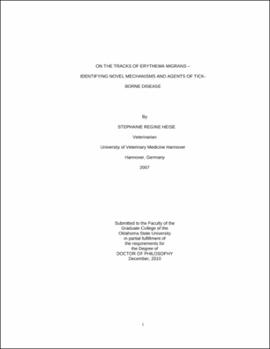| dc.contributor.advisor | Little, Susan E. | |
| dc.contributor.author | Heise, Stephanie Regine | |
| dc.date.accessioned | 2013-11-26T08:35:15Z | |
| dc.date.available | 2013-11-26T08:35:15Z | |
| dc.date.issued | 2010-12 | |
| dc.identifier.uri | https://hdl.handle.net/11244/7662 | |
| dc.description.abstract | Amblyomma americanum, the lone star tick (LST) is the most commonly reported tick from humans in the southern United States and is associated with transmission of diseases, including STARI (southern tick-associated rash illness), a Lyme disease-like illness of people of unknown etiology, and ehrlichioses caused by Ehrlichia chaffeensis and Ehrlichia ewingii. To better define the microbial communities within A. americanum, colony-raised and wild-caught ticks, including those associated with a STARI case, were analyzed before and after feeding using a 16S rDNA-wide PCR approach followed by phylogenetic analysis of sequences; ticks were further evaluated by specific PCR for Borrelia spp., Rickettsia spp., and Ehrlichia spp. The data gained in these studies provides a thorough microbial characterization of the tick of interest, A. americanum. It provides support for previous work documenting frequent infection of LST with Rickettsia spp., all members of the spotted fever group, and confirms the preponderance of R. amblyommii in all life stages as well as the presence of Borrelia lonestari, another putative agent of STARI, in wild LST populations. Upon feeding, the bacterial community present in these ticks shifts significantly, with a dominant rise of the proportion of sequences associated with the genus Rickettsia. The development of an animal model provides a new prospective for the study of STARI. New Zealand white rabbits infested with wild-caught LSTs developed distinct circular erythematous lesions expanding from individual bite sites; similar lesions were not documented in rabbits infested with colony-raised LST suggesting that the lesions were induced by an agent transmitted by the tick rather than the tick itself. However, while R. amblyommii and B. lonestari were amplified from fed wild-caught ticks, no specific pathogens were amplified from the rabbits. | |
| dc.description.abstract | Taken together these studies work towards greater understanding of the etiology of STARI and provide valuable tools to be used in future research. | |
| dc.format | application/pdf | |
| dc.language | en_US | |
| dc.rights | Copyright is held by the author who has granted the Oklahoma State University Library the non-exclusive right to share this material in its institutional repository. Contact Digital Library Services at lib-dls@okstate.edu or 405-744-9161 for the permission policy on the use, reproduction or distribution of this material. | |
| dc.title | On the tracks of erythema migrans - Identifying novel mechanisms and agents of tick-borne disease | |
| dc.contributor.committeeMember | Snider, Timothy A. | |
| dc.contributor.committeeMember | Reichard, Mason V. | |
| dc.contributor.committeeMember | Jaworski, Deborah C. | |
| osu.filename | Heise_okstate_0664D_11178 | |
| osu.accesstype | Open Access | |
| dc.type.genre | Dissertation | |
| dc.type.material | Text | |
| dc.subject.keywords | amblyomma americanum | |
| dc.subject.keywords | erythema migrans | |
| dc.subject.keywords | phylogeny | |
| dc.subject.keywords | stari | |
| thesis.degree.discipline | Veterinary Biomedical Sciences | |
| thesis.degree.grantor | Oklahoma State University | |
